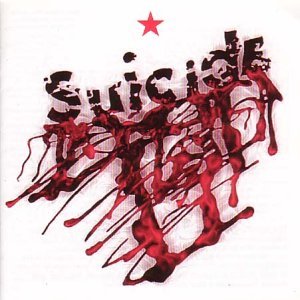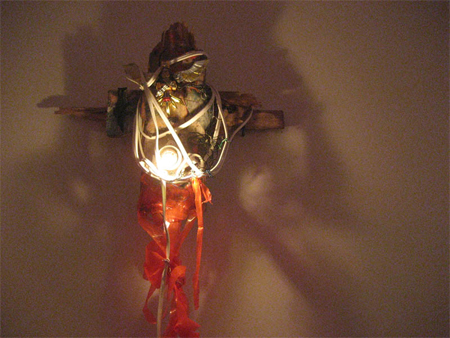Suicide’s punk fliers

"I titled it a ‘punk music mass’. Little did I know that a few years later punk was going to become this big thing. I was saying it more like a joke, because in Brooklyn in those days calling someone a punk meant they were chickening out, of a fight or whatever – the opposite of what its become." – Alan Vega
New York, 1970. A scrappy flier appears promising a "punk" show from a new duo called Suicide at the Project Of Living Artists space in Manhattan. It is one of the first uses in a musical context of that four-letter word that came to define the late 1970s. Who knows who went to that show. If anyone did, they probably hated it, setting the tone for the next six (or so) years of disdain (at best) and outright, violent hostility that Suicide would have to face before the eventual release of their debut album. Suicide would describe themselves as "punk" on fliers for the next few years… until 1974, when gigs would be heralded as "rocket rock" or "dream rock". Go to the From The Archives site to see all the fliers.
Suicide – Suicide (1977)
"The thing about Suicide is we knocked off about five sacred cows at one time. It wasn’t just the name, it wasn’t just what we did onstage. The fact that we were two guys, that’s a sacred cow, then we had no guitars, no drums, so we’re hitting it on three or four levels." Martin Rev

The seven tracks that make up this debut record are in a sense a distillation of the musical sketches that Suicide had been playing live ever since those performances early in the 1970s. They arguably only came to light thanks to the efforts of former New York Dolls manager Marty Thau, who signed the band to his Red Star label and lent his guiding hand to the recording process. ‘Cheree’, which you can perhaps term the album’s only ballad, is unsettling, a twinkling melody like an ice cream van driven by a deviant over a simple one-finger organ refrain, Vega singing to "my black leather lady"; ‘Ghost Rider’ takes the American myth of the freedom of the open road and turn it into something mechanically cold and strange – this dystopian sensibility was surely what caught the ears of MIA and her producers when they borrowed the track for new single ‘Born Free’. Yet no amount of exploding gingers can top the eerie horror of ‘Frankie Teardrop’, arguably one of the most distressing pieces of music ever recorded. The story of a factory worker who cracks and shoots his wife and child before turning the gun on himself, it consists of nothing more than a high BPM pummel, a hissing eddy, a see-sawing drone and Vega’s rockabilly "uh huh" suddenly given way to chilling screams. Martin Rev says that ‘Frankie Teardrop’ "reflects the whole working class experience, those things that pop art wasn’t addressing."
Alan Vega’s light sculptures
"You push the piece to a certain point and as hard as you try to change what’s happening you can’t, it’s got a life of its own and you’re just a puppet. After two thirds of the way through just forget about it. It’s beautiful to be taken over like that, it’s a body snatch." – Alan Vega

Vega and Rev first mat at New York’s Project for Living Artists, where the latter was squatting in a janitorial capacity while working on the light sculptures that have made for the focus of his visual art ever since. Often based around cruciform structures bound in wire and urban detritus, like Suicide’s music, they explore the broken iconography of America. Vega was never widely accepted by the art world, and a feeling of mistrust was certainly mutual – although he had gallery representation in New York thanks to Pop Art impressario Ivan C Karp, Vega was never down with the post-Warhol scene. "People getting wealthy on fucking Vietnam. The same people buying all the art. It’s blood money baby, it’s all about blood money," Vega told me a few years ago. The first major exhibition of Vega’s art took place in Lyon in 2009, and there are plans to mount a major show in London later this year.
Alan Vega – ‘Jukebox Babe’
"I always wanted to do a rockabilly record because Elvis Presley to me is like God, and Roy Orbison and Jerry Lee Lewis, they’re my triumvirate. Next thing I know I’m off to Europe and I’ve got a fucking hit song. Nobody told me this record is going to be a hit, I thought it was going to be like Suicide, fade away and do nothing." – Alan Vega
Released in 1980 on Alan Vega’s eponymous debut solo album, ‘Jukebox Babe’ was an unexpected hit for Vega, especially in France Though ostensibly a straight-up piece of rock ‘n’ roll classicism, there’s still something unnerving about the track’s skittish pace, the sudden drum crashes, and a sense of pace that recalls ‘Ghostrider’. Anyone further interested in Vega’s solo career should cast an ear over Station, the phenomenal 2007 record of Boyd Rice-esque industrial noise, teeth-cracking beats and bleak, state of the nation lyrical polemic. Martin Rev’s solo work, meanwhile, has increasingly led him to map out the more ambient spaces explored to great success on last year’s Stigmata
For the love of Bruce
"… I never heard anything avant-garde. To me it was just New York City Blues." – Alan Vega, speaking in 1980
The above quote goes a long way to explain the affinity between Bruce Springsteen and Suicide. Musically they might be light years apart, but the common lyrical theme of the blue collar struggle hit a nerve with Springsteen, who said that the track ‘State Trooper’ (from his album Nebraska) was heavily influenced by ‘Frankie Teardrop’, which he has described as "one of the most amazing records I think I ever heard". He paid even finer tribute with a cover of ‘Dream Baby Dream’ to close his Devils & Dust Solo Acoustic Tour. Featuring just Springsteen on droning organ, his vocals lift it into a sumptuous torch song:
Suicide’s Second Album
If Suicide was a record condensed from fragments of tracks into a nailed plank smacking into the senses and sensibilities of the listener, the follow-up was a more considered, but no less forward-thinking affair. The sinister pulsing beats remain, but Martin Rev lays down further layers of synthesiser and pretty melodies behind a fuller tuneful croon, but no less politically engaged, vocal from Alan Vega. There’s contrast too between the almost slinking ‘Diamonds, Fur Coat, Champagne’, the wobbling pop of ‘Fast Money Music’ and ‘Shadazz’ and the heavy, sinister throb of ‘Harlem’, a reflection of what Throbbing Gristle were up to on the other side of the Atlantic. This record was arguably a turning point. It’s no secret that Suicide were a huge influence on the likes of Soft Cell and other synth pop groups of the early 80s. In another world, might Suicide have followed their under-acknowledged melodic instincts and become a pop group?
Alan Vega 10" series
To commemorate the Suicide vocalist’s 70th birthday, Blast First Petite are in the middle of an ongoing series of limited edition 10". These feature the songs of Suicide and Alan Vega reinterpreted by musicians ranging from Bruce Springsteen (whose Dream Baby Dream mentioned above has been released), Primal Scream, Factory Floor’s Nik Void, Lydia Lunch, Peaches, Klaxons and Sunn O))), who, with Pan Sonic, take the descending chords of ‘Che’ deep into the void.
Suicide Live box set
"We taped everything; we’d listen back to it and think, what the fuck are we doing? We’d cause riots almost every night. There wasn’t a show go by when we wouldn’t be bleeding. Or they’d leave. There’d be a hundred people in the crowd then within five minutes they’d all be gone except for one or two lunatics who were loving it." – Alan Vega

Released in 2008 (and reviewed on the Quietus here. This five disc compilation, again released by Blast First Petite, features unmastered, warts and all recordings made by Howard Thompson, who first brought Suicide’s music to the Europe when he released the debut album on his Bronze imprint. Looking behind the lo-fi recording, crowd chatter picked up by the microphone, though, and you glean a glimpse of a group who paid scant respect to traditional notions of what a gig ought to entail, each night a radically different presentation of their bare bones: Rev’s synthesiser and organ attack, Vega’s Elvis ghoul. What’s more, as well as the notorious ’33 Minutes Over Brussels’ where Suicide provoked a riot when supporting Elvis Costello, many of the recordings show applause winning out over the boos.
Suicide supporting The Stooges, May 3 2010
It was something of a surprise when Suicide announced that they’d be performing their debut album as a Don’t Look Back from ATPNY – they’re hardly a band who deal in reverence. What Suicide proved is that in 2010 they’re just as iconoclastic and important as they ever have been. With a bracingly loud PA, they don’t perform a hallowed tribute to their own edifice but, as ever, continue to challenge. On Sunday, Martin Rev sported a flashing blue light visor as he hammered away at his keyboard, playing with the back of his fist as much as his fingers. Alan Vega, in shades and curious cloth hat, prowled the stage shouting, making unusual gesticulations, and occasionally throwing his microphone to the floor. Fragments recognisable as ‘Che’, ‘Ghostrider’ and ‘Johnny’ are crunched by Rev and drenched in vocal reverb by Vega as The Stooges’ black leather clad lager-swilling crowd looked on, many seeming rather bemused by such irreverence. For Suicide, some habits clearly die hard.
Originally published May 2010


